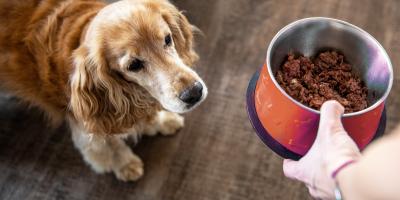How to Teach an Old Dog New Tricks


We’ve all heard the phrase that, You can’t teach an old dog new tricks. Thankfully, this saying happens to be incorrect. It turns out that you CAN and SHOULD teach an old dog new tricks. Not only will this keep them mentally stimulated as they become a senior, but this will alleviate boredom while keeping the bond strong between you and your old pal. In turn, they will be happier for the fun activities along with the extra love and attention from you.
Right now, you might be wondering, How do I teach an old dog new tricks? Thankfully, there are many easy dog tricks for older dogs. In fact, teaching an old dog new tricks doesn’t have to be difficult and can be a rewarding experience for both of you. However, you will want to keep in mind that your buddy is getting older and might have some health issues to take into consideration, such as dementia, hip dysplasia, arthritis, deafness, eye issues, dental health concerns, and more. As you teach them new tricks, it is important to ensure you are providing them with the right care and preventing them from getting injuries. Start with tricks that you know they are capable of learning, such as simple dog obedience commands like “sit” or more advanced commands like “put away your toys.” Which tricks to teach your buddy is really going to be dependent on their overall health and their physical abilities. At the very least, teaching new tricks to old dogs is a great way to keep them fit and have fun!
Can You Teach an Old Dog New Tricks?
You might wonder if it’s hard to teach old dogs new tricks. While you most likely will need more patience and compassion when training an older dog, it shouldn’t be any more difficult than teaching a puppy. In fact, older dogs usually have longer attention spans than their younger counterparts allowing for longer training sessions. They are also more receptive to learning new tricks and commands due to their previous training experiences as well.
Although your dog might not be physically able to do tricks, such as learning to jump through hoops, they can learn commands more applicable to their current senior physique. Make sure you are always placing their physical and emotional needs first when you teach your buddy new tricks. Keeping them calm, comfortable, and happy during the sessions is crucial for their success and overall health. When it comes to teaching an old dog new tricks, the focus should be on spending quality time with your pal and having a good time together. This will only increase their love toward you as the two of you bond in these new and fun training activities.
Things to Consider When Teaching a Senior Dog
The top things to consider when teaching an old dog new tricks are their physical and mental abilities. If they have joint issues or muscle disorders, then it might be difficult to do tricks like lying down, jumping, or performing repetitive movements. Choose tricks that promote slower and less repetitive movements, such as touch. If your dog has sight and hearing problems, then adjustments will need to be made for them to overcome these things. For example, instead of using verbal cues for a deaf dog, you can change it to hand cues. If your buddy has dental issues, then picking items up might be hard for them and tricks like this should probably be avoided under such circumstances.
Cognitive issues will also need to be considered when teaching your old dog tricks. Older pets might forget some of their previous training, in which case they will need a refresher course. They might develop anxiety as they age where you will need to prioritize their emotional well-being before, during, and after each training session. Some dogs might have disruptions in their sleeping patterns, which could interfere with their training, especially if there is an underlying medical condition that is contributing to this situation. Make sure to talk to your vet about any health concerns you might have for your dog prior to any training. You can even ask them for their suggestions on how to teach your old dog new tricks if there are any health concerns present, so they can stay happy and well.
Tricks for Older Dogs
If your buddy hasn’t trained for a while, it might be good to start with a primer and review the basics. It’s also fun to add on to what they already know. For example, if your dog already knows the “sit” command, then you can add on to this by teaching them the “shake a paw” command. From there you can move on to completely new tricks that will increase the confidence in your elderly dog while keeping them engaged and sharp as they age.
Below are a few easy dog tricks for older dogs:
- Shake
- Touch
- Heel
- Speak
- Yawn
- Put away your toys
- Kiss
- Bow
- High five or wave
- Names of objects
- Back up or walk backwards
- Fetch something from the fridge
- Ring a bell
- Get your leash
- Hold an object
- Find it
- Cover up with a blanket or tuck yourself in
- Crawl
- Push a ball
- Roll over
- Come into my arms
As mentioned above, revisiting old tricks they have already learned is a nice way to restart their dog training sessions, especially if they are experiencing some age-related cognitive decline and could use the reminders. If you need more senior dog training ideas, the myPurina app is a great resource to go to if you are looking for free and enriching training content for you and your dog. If they are still capable, you might even assist with their training and mental stimulation by playing games with your buddy and rewarding them with plenty of treats, praises, toys, and love throughout each session. Finally, you can always talk to your vet to get their advice on how to teach an old dog new tricks. Even if your buddy doesn’t quite get the trick you are trying to teach them, they are at least getting good exercise and will enjoy the time they spend with you. As a result, trick training will only bring the both of you closer together, making their golden years the best that life can offer.
Tips for Teaching an Old Dog New Tricks
To review the above, here are a few tips to keep in mind when you teach your buddy new tricks:
- Prioritize their physical, mental, and emotional well-being before, during, and after each training session
- Learn how to adjust and adapt tricks to meet their physical and mental needs
- Avoid tricks that can cause your buddy injury or discomfort
- Choose tricks that have slower and less repetitive movements in them
- Start with commands they already know as a refresher
- Add on to commands they've already got down as a next step
- Once they have been properly primed, begin teaching them new tricks
- Play learning games that engage them mentally to keep their minds active and sharp
- Use the myPurina app to search for more free, enriching training content for your pal
- Reward them with plenty of treats, toys, praises, and other positive reinforcement throughout each session
- Talk to your vet about any concerns or for advice
Finally, the goal for each training session should be focused on getting them some exercise according to their abilities and increasing your bond with your pal. This way they will love you to the end of their days.
For more expert tips on the behavior of your senior dog, explore our other senior dog behavior articles.

Be Rewarded for Your Purina Purchases
Earn and redeem points for Purina products with myPurina app.






